Apple's 2010 MacBook Air (11 & 13 inch) Thoroughly Reviewed
by Anand Lal Shimpi on October 26, 2010 10:08 PM EST- Posted in
- Mac
- Apple
- MacBook Air
- Laptops
The 11-inch as a Windows Notebook
As a follow-up to our Nvidia 320M/MacBook Pro 13 article last week, I’ve been running our Windows test suite on the MacBook Air 11”. I, like Anand, have the lowest end 11”er, with 2GB memory and the 64GB SSD. This makes installing Windows an interesting proposition since after the two OS installs, you’ve got right around 30GB of free disk space to work with. My suggestion - if you plan on installing Windows and dual booting often, save yourself the headache and get the 128GB model.
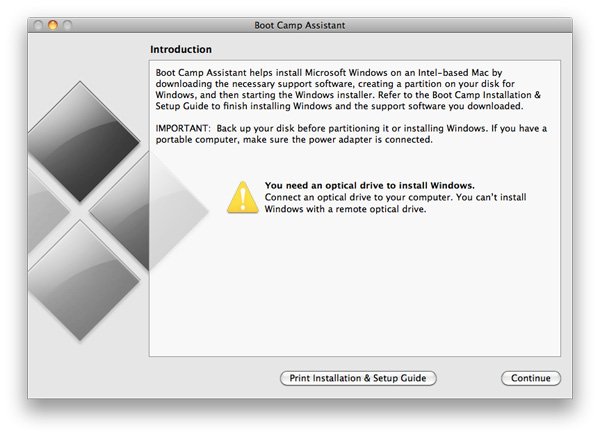
The other quirk with putting Windows on the Air is that it must be done with a USB optical drive - no hard drive/thumb drive installs. Interestingly, my external optical drive wasn’t recognized as a bootable drive, so I had to run out and grab an Apple SuperDrive. Apple says that you just need an external DVD drive, without specifying the MacBook Air SuperDrive, but your mileage may vary.
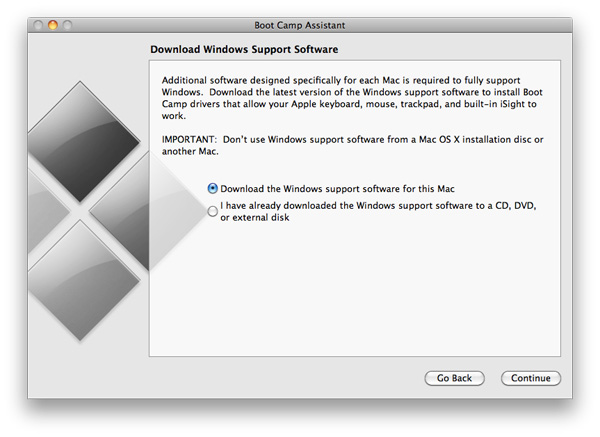
Boot Camp Drivers are now downloaded from Apple's servers prior to the Windows installation
With the Windows install out of the way, we were free to test the living daylights out of it, and that we most certainly did. The 11” Air has the same 1.4GHz Core 2 Duo SU9400 as the similarly thin Dell Adamo 13. Months after we move to Arrandale ULV, leave it to Apple to bring the good old CULV platform back to relevance. As expected, Cinebench and the x264 encoding test gave us results around the same level as the Adamo and the rest of the old CULV gang. Versus the 13” MacBook Pro, you’re looking at roughly a 40% decrease in the CPU compute-heavy benchmarks, roughly equivalent to the reduction in clock speed from the 2.4GHz Pro to the 1.4GHz Air. Arrandale ULV notebooks, such as the Alienware M11x and its Core i7-620UM, are another matter entirely, with the newer architecture posting numbers nearly doubling the Air’s Core 2 processor.
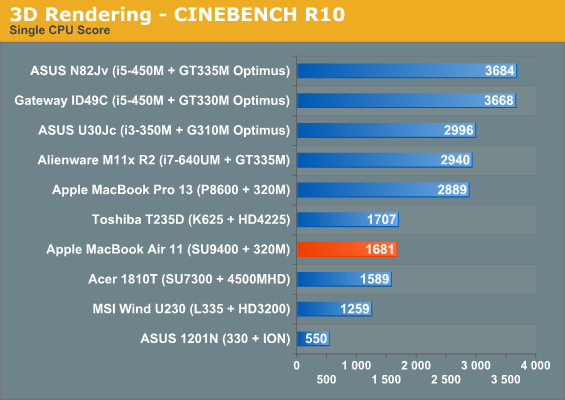
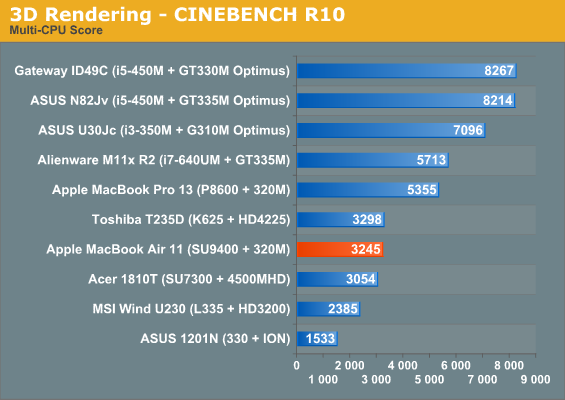
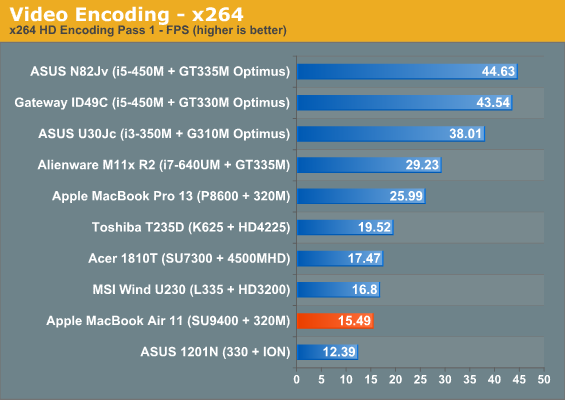

The gaming benchmarks get a bit more interesting. We’re looking at the same GT 216-derived GeForce 320M that was in the MacBook Pro 13, with the same 450MHz core and 950MHz shader clocks. Based on the performance we saw out of the Pro 13, we know that the Air, even in 11” form, can still hold its own in games.
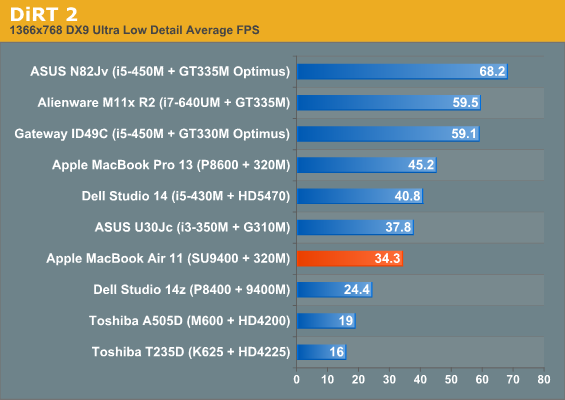
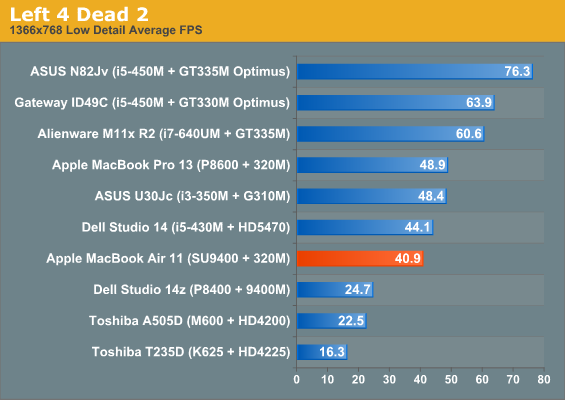
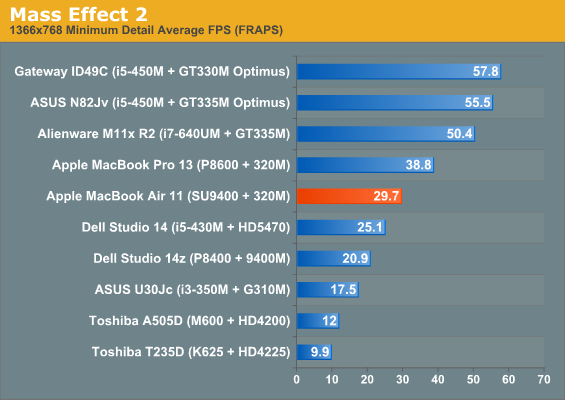
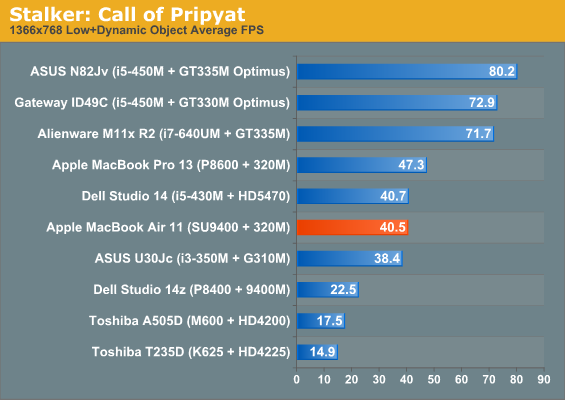
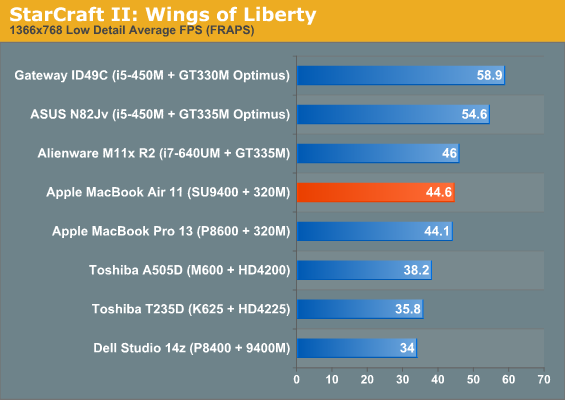
At low detail settings, the Air is pretty consistently 20% slower than the Pro 13, except in SC2, where they were roughly equal. Given that the GPU is identical and that both are using 256MB of the system’s DDR3 1066 memory, it is likely that the 1.4GHz Core 2 Duo is slow enough to put a bottleneck on gaming performance. It’s still a ways ahead of the ASUS Core i3/G 310M combo, and all of our games are playable at native resolution.
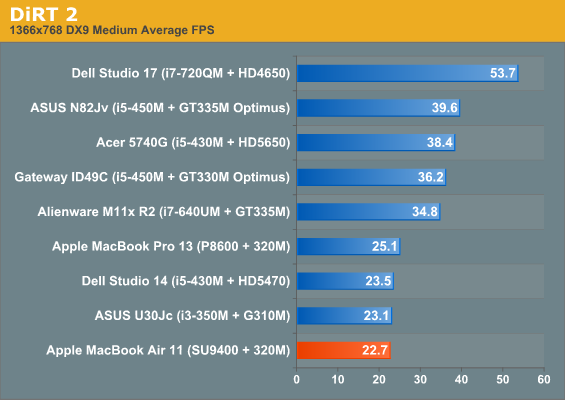
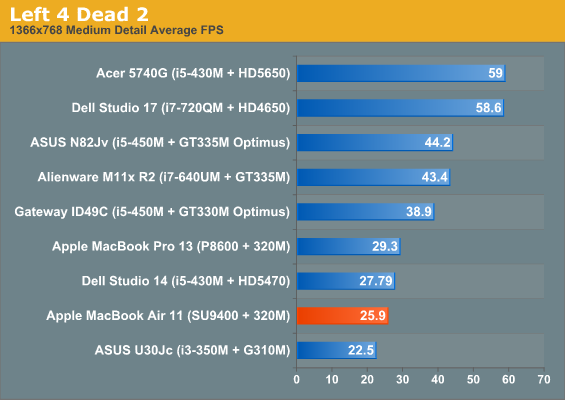
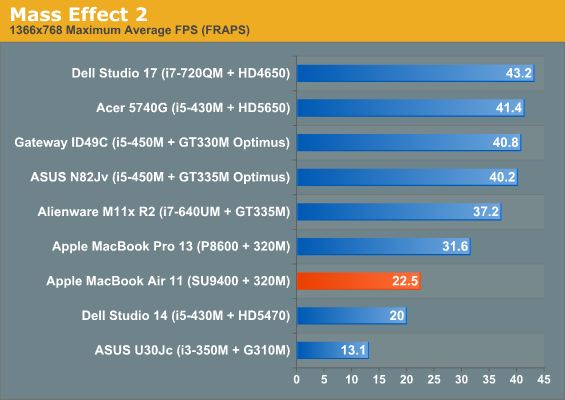
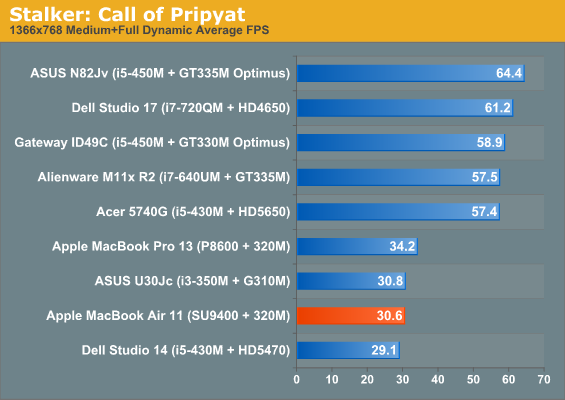
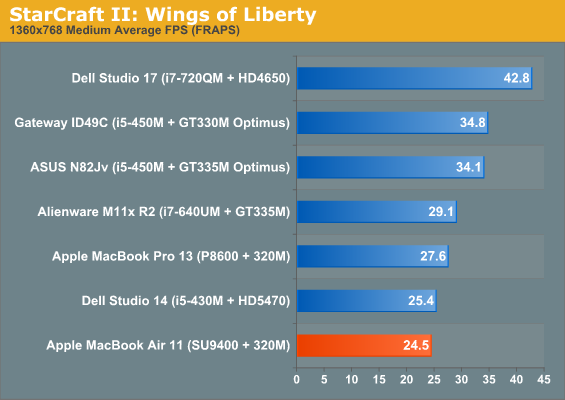
At medium settings though, the Air starts to fall off a bit. Where the MBP13 was borderline-playable, always between the 25-35 fps range, the Air is about 10% behind and makes it to the magical 30fps mark in STALKER, but nothing else. DiRT 2, Left 4Dead 2, Mass Effect 2, and StarCraft II all ended up between 22 and 26 fps, still faster than the G 310M, but not quite playable. Another interesting concern during gaming is heat. The Air isn’t the coolest notebook in the world, with idle temps hovering around 50C, but while running the gaming tests, I saw GPU temps rise up into the 70s. Nothing too alarming, but still pretty toasty and more than enough to get the fans spinning to the max.
But let’s put this all in perspective. This isn’t about just an 11.6” notebook that can game - the 11.6” M11x is the fastest gaming notebook under 5lbs, but even then it’s still a full two times heavier than the MB Air 11. The Air 11 shoehorns quite a bit of power into one of the smallest form factors on the market. Having a GT 216 core in an enclosure this small and being able to run these games at 40 fps at native resolution is definitely very impressive.










185 Comments
View All Comments
dsee15 - Wednesday, October 27, 2010 - link
Great thanks. Until then as a technical site, does anyone have a sense what the faster proc and additional 2GB mem do to performance? For example, it should run 20% faster for cpu intense apps, etc.Shadowmaster625 - Wednesday, October 27, 2010 - link
Well if you're spending money on any of these crapple concraptions then you are either not being productive or simply getting paid too much. Like those retired public employees who get paid 6 figure pensions for doing nothing. I dont know when that crap will stop, but I imagine it will be at around the same time apple flirts with bankruptcy.michael2k - Wednesday, October 27, 2010 - link
They have more cash than Microsoft. So after Microsoft flirts with bankruptcy?Shadowmaster625 - Wednesday, October 27, 2010 - link
They do have a lot of cash. But I can easily see them burning up half of it buying back their own stock once it starts tanking. And the other half could be burned up by just one or two flops. And that can easily happen once most apple lovers realize we are in fact in a depression and there is just no place for a company like apple in a depression.ShepherdH - Wednesday, October 27, 2010 - link
they just gave you more RAM and a larger hard drive at them. Same with most other Apple products.iwodo - Wednesday, October 27, 2010 - link
When Apple gets SandyBridge, i suspect 32nm, SandyBridge 1.8Ghz could do so within the same 1.4Ghz C2D Power envelop. But will be much more powerful. The only trouble is Apple wants CPU to be CPU, not a CPU with GPU built in.khimera2000 - Wednesday, October 27, 2010 - link
im not sure about that. they might just be looking for a sweet spot with CPU and GPU performance. in which case AMD's APU chips should be an intresting prospect since it gives you modern architecture on both sides in one chip.where intel took two dies and just slaped them together,AMD made it so the CPU and GPU can actualy talk to each other, also if AMD is to be beleaved this core would be retasked in the presance of another AMD card so the video chip on the CPU dosent become dead weight like the intel solution which just shuts down entirely in the presence of another card. (at least thats what i read)
personaly i think apple should get back into building there own hardware just like the g4 days. but that would require building there own OS, and seeing as mac hasent built an OS from the ground up for a long time (last time being os9? check out something called OpenStep) it might not be in there best intrest with win 7 getting so much traction and the failings of there previous Operating Systems it might not be good for the company to build something there not good at creating.
khimera2000 - Wednesday, October 27, 2010 - link
actually i dont think thats the case. there looking for a balanced system, and to this day intel has not released anything that can run a modern title (that i know of) if intel had a half way descent architecture on there vid cards i could see apple using it.however as things stand intel does not have a descent processer, and thats the reason why they have to use an nvidia video card. being that these notebooks use intergrated memory i can see that apple is looking for a specific perfomance point for there systems.
with that in mind i dont see why they wouldent consider AMD's soon to releas offerings. these chips has better gpu/cpu intergration then intel's options and sports the latest DX11 video architecture AMD has. I dont think theres anything in intel's arsinal that would be able to but heads with these chips from a graphic stand point, the only rogue facter in this is the new CPU architecture, since it has to yet be released.
Speaking of which... when can we expect to see reviews of the amd APU offerings from Anand? i would love to see how well it ticks, and a review to better define what makes it so differant from the intel chips that are comming out... perhaps an architetual comparison sometime in the future???
khimera2000 - Wednesday, October 27, 2010 - link
wow... i didnt know my first post went through for this response.. sorry about that. my connection hickuped. Love the sight keep up the good work :Dblufire - Wednesday, October 27, 2010 - link
You stated that the software restore drive is not write-protected, but Apple states that it is read-only. Who's right?http://support.apple.com/kb/HT4399
Thanks for the review!